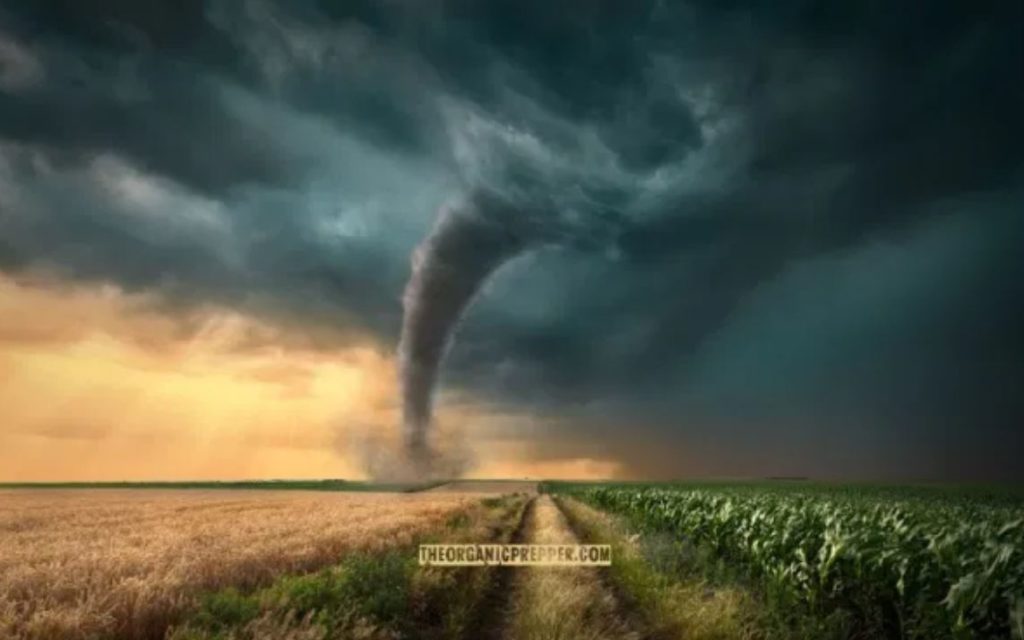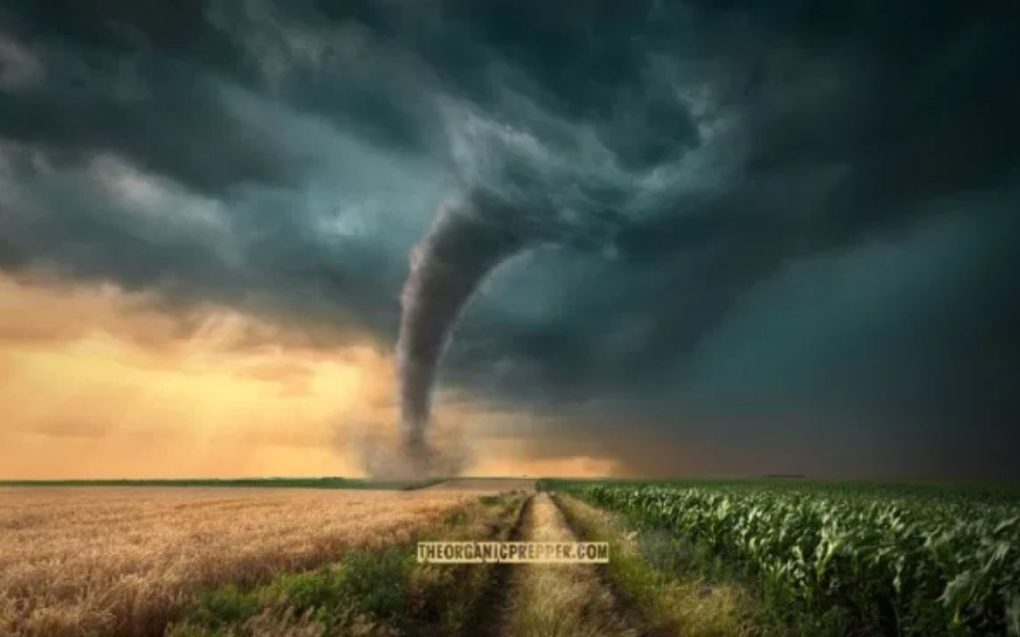URGENT: Extreme Level 5 “High Risk” Warning of Severe Tornado Outbreaks Across SE
 By Daisy Luther
By Daisy Luther
Anyone who lives in certain parts of the country knows the signs of an approaching tornado. The wind is whipping things around and the sky turns an indescribably dark yellow-green color.
Sometimes there’s hail and heavy rain that suddenly stops. The wind changes. And there’s nearly always a loud, persistent roar that becomes more deafening the closer the tornado gets.
Widget not in any sidebars
When you see signs like that, you know it’s time to take shelter immediately. These days, we have more advanced warning systems that dispatch warnings to cell phones in a local area, TV stations interrupt programming, and warning sirens begin blaring.
Tornadoes can appear quickly and without any warning, so your goal should be to have a shelter with supplies already set up well before the wind starts to blow. Once you can see the twister, you won’t have time for anything but getting to the shelter. It’s also important to note that in the past few years, tornadoes seem to occur in groups, making them a far more widespread threat.
The following is an excerpt from my book: Be Ready for Anything
Where to shelter if you’re at home
First things first. Mobile homes are absolutely not safe in a tornado, no matter how well they are secured. If you live in a mobile home, you should have a secondary underground shelter or seek shelter in a nearby building.
Creating a tornado shelter is something everyone in tornado-prone areas should do. Because we all have different settings, here are the best places to shelter at home.
The best bet is a storm cellar that has been dug outside the home. These are superior because there is less risk of being trapped in there by the debris of the house above it. It should be in a location that allows quick access but isn’t so close that the house can collapse upon it. For this reason, you’ll see that many storm shelters have doors set at an angle. Keep supplies like food, water, sanitation, and first aid kits in the shelter in case you are stuck in there for a while.
The next safest place is the basement of your home. Find a spot in the basement that isn’t directly under something heavy on the main floor, like a piano or a refrigerator. Make sure you are as far away from any windows as possible. In that area, place some kind of sturdy protection like a heavy table, desk, or workbench. Keep the area underneath it clear so that you and your family can take shelter in it immediately. Keep mattresses or sleeping bags nearby to pull over everyone to protect them from flying glass and debris. For extra protection, keep helmets in the area too. (Bicycle, football, etc.)
If you don’t have a basement, find the most protected spot. Go to the lowest floor possible and find a place that is close to the center, without any exterior doors or windows. Get in a bathtub and pull a mattress or something sturdy over your family. Alternatively, seek shelter in a windowless hallway, under the stairs, or in a closet. Always try to pull something over yourself and your family, like a twin sized mattress or blankets to help protect you from debris or flying glass.
What to do if you’re driving
If you happen to be in your car or truck when there is a tornado headed your way, you’re stuck with the slightly-less-deadly option over the definitely-deadly option. If it’s far enough away, you may be able to get out of the path of the storm by turning at right angles, but keep in mind that tornadoes are prone to change directions quickly.
If you can find a low place like a ditch to get to, exit your vehicle and lay face down at the lowest possible point. Cover your head with your hands and if possible, bring a blanket or coat from the car to put over yourself.
Get Non-GMO storable food HERE!
If there are no low points, pull off the road, turn off your car, and remain seat belted. Cover yourself with a coat or blanket and tuck your head below the level of the windows. DO NOT PARK UNDER A BRIDGE OR OVERPASS.
What to do if you’re not at home
I’ll never forget when a tornado hit our school when I was in 9th grade. The noise was deafening and when it hit, I could no longer hear the kids who were crying and screaming. We crouched in the hallway and stuck our heads in our lockers as directed.
Fortunately, no one was seriously injured but it left an indelible impression of the power of Mother Nature.
If you are not at home, but you are indoors, go to the lowest level of the building you can get to. Stay in the center of the building if possible – stairwells are a good option. Stay as far away from windows, doors, and potentially deadly flying glass, as possible. Stay out of large, open spaces like gyms and auditoriums. DO NOT take an elevator to try to get to a lower floor faster.
What to do if you’re outside
If you are outdoors, try to get to a sturdy building. If you are not able to get to a sturdy building, find the lowest point possible, like a ditch, to lay down, and cover your head with your arms.
If there is no low point where you can seek shelter, lay down flat on your stomach and cover your head with your arms. Stay as far away as you can from trees, cars, and other large objects that could fall or be blown onto you.
What to do after the tornado
Just like an earthquake, the aftermath of a tornado can be just as deadly as the twister itself. The level of destruction may be shocking.
Keep family members close together and warn children not to touch ANYTHING. If anyone is injured, provide first aid. Watch out for
- Downed power lines
- Puddles with wires in them
- Broken glass
- Nails
- Sharp debris
- Raw sewage
Do not go into any damaged buildings – they could collapse. Do not use matches or cigarette lighters. If a natural gas pipe or fuel tank is leaking, the could explode with the introduction of a flame.
If you have vulnerable neighbors, check to see if they need help.
Before you touch anything or try to set it to rights, take pictures of everything with your phone. You’ll need this for insurance purposes.
Check your phone, radio, or television for news. Emergency crews will most likely be out soon to render assistance and provide further information. If not, you need to check for hazards.
- Electrical Issues: Be on the alert for sparks, frayed wires, or burning smells. If you detect any of those, turn off the main breaker to the house as long as you can get to it without stepping in water. Call an electrician.
- Gas Leaks: If you smell gas or hear a hissing noise, open the window and get everyone out of the building immediately. Turn off the gas at the exterior valve and contact the gas company.
- Chemical spills: If substances like medicines, bleaches, or gasoline or other flammable liquids have spilled, clean them up as quickly as possible.
If you live in a tornado-prone area, make sure your children know what to do in the event of a tornado. It could save their lives if they are home alone or at school when one strikes.
Here’s some more information about tornadoes and their aftermath.
- Here’s what it’s really like when your home is hit by a tornado
- This mom saved her children’s lives during a tornado
- Here’s how to start over after a disaster
- Here’s how to replace important documents
- Click here to order Be Ready for Anything
Have you ever been through a tornado?
Have you been through a tornado? Do you have a good shelter set up? Share your advice in the comments section.
Source: The Organic Prepper



